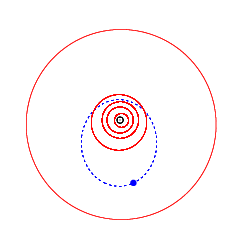9950 ESA
|
| |||||||||||||
| Discovery | |||||||||||||
|---|---|---|---|---|---|---|---|---|---|---|---|---|---|
| Discovered by | C. Pollas | ||||||||||||
| Discovery date | 8 November 1990 | ||||||||||||
| Designations | |||||||||||||
| MPC designation | 9950 ESA | ||||||||||||
Named after | European Space Agency | ||||||||||||
| 1990 VB | |||||||||||||
| Orbital characteristics[1] | |||||||||||||
| Epoch 13 January 2016 (JD 2457400.5) | |||||||||||||
| Uncertainty parameter 0 | |||||||||||||
| Observation arc | 9286 days (25.42 yr) | ||||||||||||
| Aphelion | 3.737064922180292 AU (559.05695502583 Gm) | ||||||||||||
| Perihelion | 1.14092137083548 AU (170.67940771311 Gm) | ||||||||||||
| 2.43899314650789 AU (364.86818136947 Gm) | |||||||||||||
| Eccentricity | 0.532216245679477 | ||||||||||||
| 3.81 yr (1391.3 d) | |||||||||||||
| 222.4941661252860° | |||||||||||||
| 0° 15m 31.517s / day | |||||||||||||
| Inclination | 14.58410510446003° | ||||||||||||
| 253.5630393174880° | |||||||||||||
| 103.4590154541560° | |||||||||||||
| Earth MOID | 0.281313 AU (42.0838 Gm) | ||||||||||||
| Jupiter MOID | 2.09281 AU (313.080 Gm) | ||||||||||||
| Jupiter Tisserand parameter | 3.255 | ||||||||||||
| Physical characteristics | |||||||||||||
| Dimensions | ~3km[2] | ||||||||||||
| 6.712 h (0.2797 d) | |||||||||||||
| |||||||||||||
| 16.2 | |||||||||||||
|
| |||||||||||||
9950 ESA is an Amor asteroid. It orbits the Sun once every 3.81 years.[1]
Discovered on November 8, 1990 by C. Pollas it was given the provisional designation "1990 VB". It was later renamed "ESA" after the European Space Agency.[3]
References
- 1 2 "9950 ESA (1990 VB)". JPL Small-Body Database. NASA/Jet Propulsion Laboratory. Retrieved 13 April 2016.
- ↑ Harris, A. W.; Zappalá, V. (June 1991). "Photoelectric Photometry Opportunities: May–July". The Minor Planet Bulletin. 18: 20. Bibcode:1991MPBu...18...20H.
- ↑ MPC 55720 Minor Planet Center
External links
- 9950 ESA at the JPL Small-Body Database

This article is issued from Wikipedia - version of the 9/10/2016. The text is available under the Creative Commons Attribution/Share Alike but additional terms may apply for the media files.

